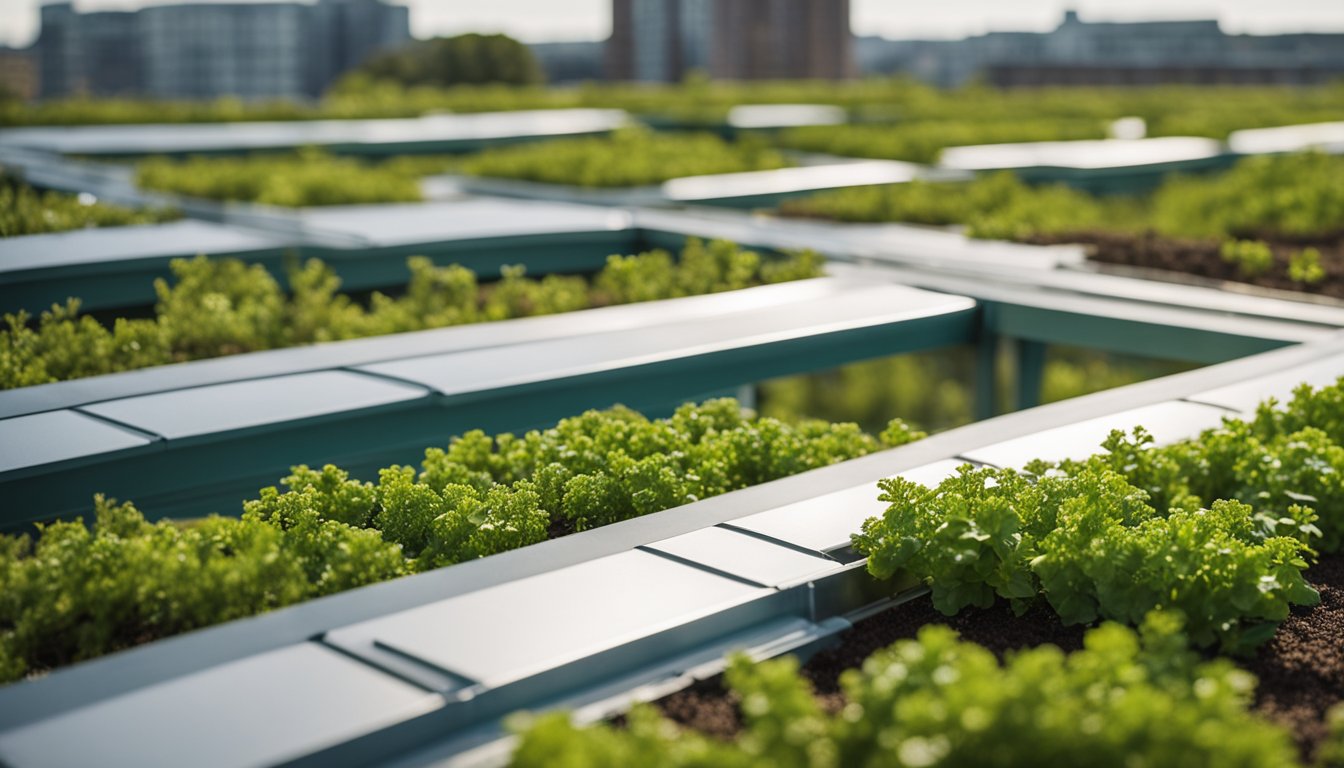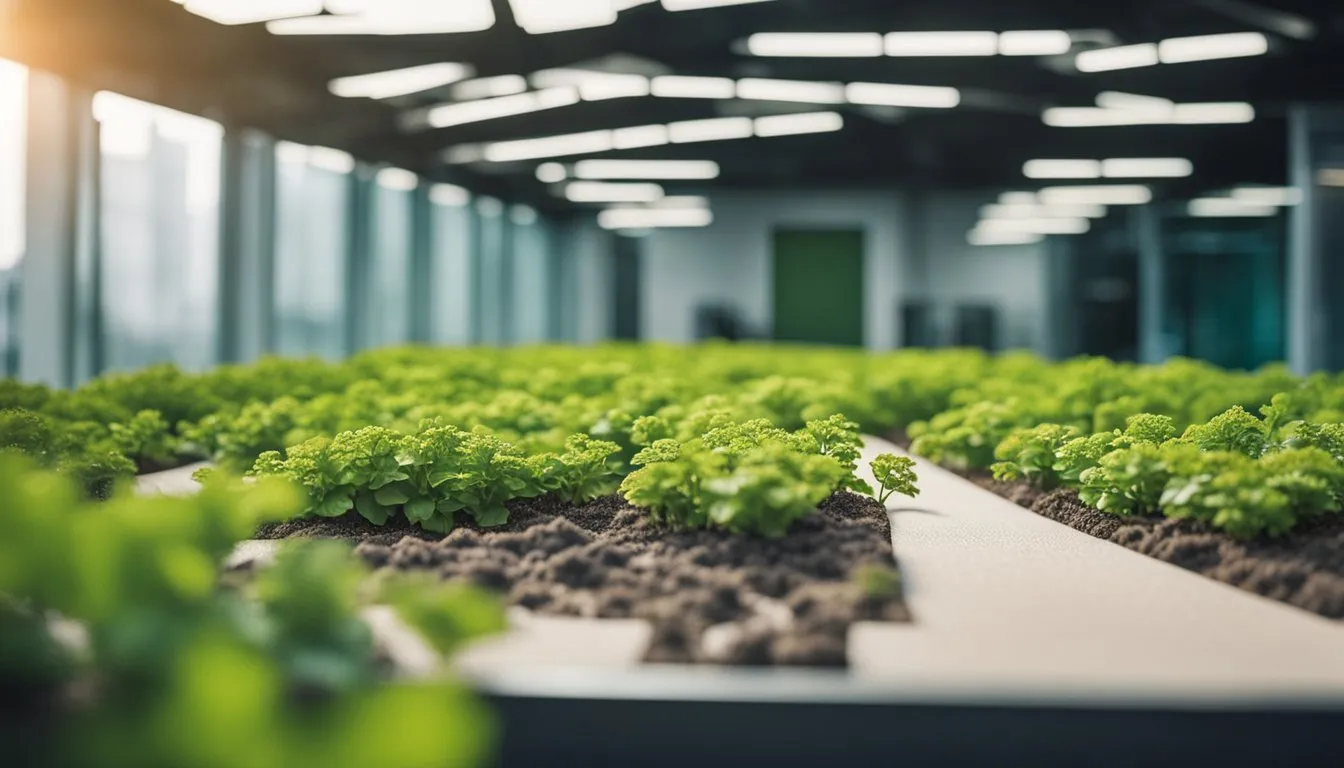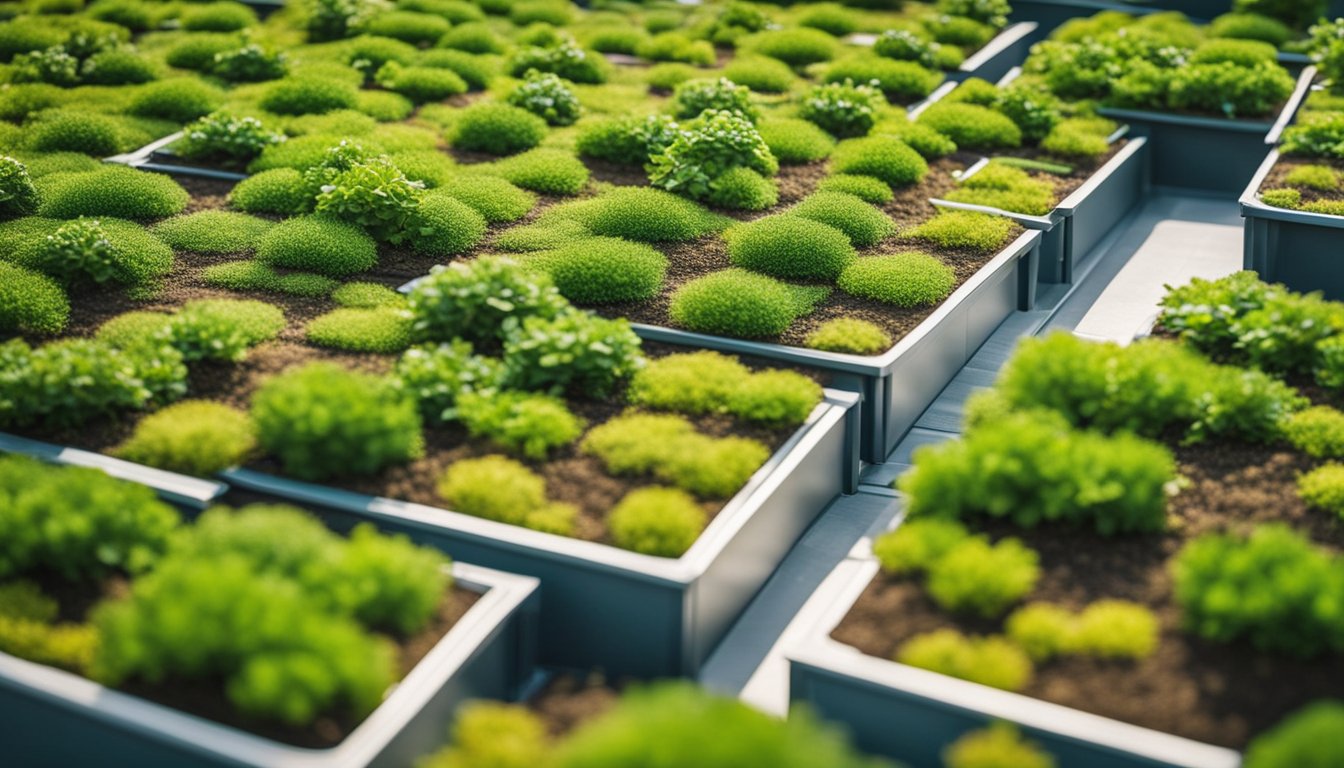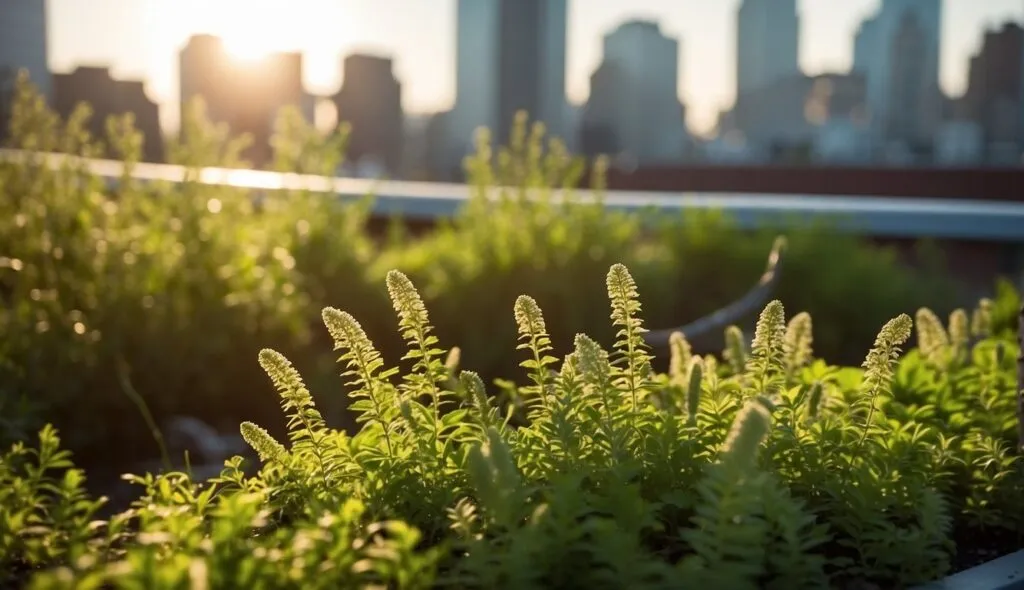Green roofs have been gaining popularity in recent years as a sustainable and environmentally-friendly roofing option. They are essentially roofs covered with vegetation that provide a range of benefits, including insulation, stormwater management, and improved air quality. The insulation benefits of green roofs are particularly noteworthy, as they can help reduce energy consumption and costs associated with heating and cooling buildings.

Green roofs can help reduce energy consumption by providing insulation to buildings. According to a study by the National Research Council of Canada, green roofs can reduce the amount of heat lost through a roof by up to 75%. This can lead to significant energy savings, as less heating is required to maintain a comfortable indoor temperature during the winter. During the summer, green roofs can also help reduce the amount of heat absorbed by a building, which can help reduce the need for air conditioning.
Table of Contents
Key Takeaways
- Green roofs provide insulation benefits that can help reduce energy consumption and costs associated with heating and cooling buildings.
- The insulation benefits of green roofs can help reduce the amount of heat lost through a roof by up to 75%.
- Green roofs can also help reduce the amount of heat absorbed by a building during the summer, which can help reduce the need for air conditioning.
Environmental Advantages
Green roof insulation offers several environmental advantages that make it a sustainable and cost-effective solution for building owners and communities. In this section, we’ll explore some of the key environmental benefits of green roof insulation.
Reduction of Urban Heat Island Effect
Green roofs help to reduce the urban heat island effect by providing a layer of insulation that reduces the amount of heat absorbed by buildings and surrounding surfaces. According to the US EPA, green roofs can reduce surface temperatures by up to 90°F compared to traditional roofs. This can help to reduce the energy needed for cooling buildings, which in turn reduces greenhouse gas emissions and helps to mitigate the effects of climate change.
Stormwater Management Enhancement
Green roofs can also help to manage stormwater runoff by absorbing rainwater and reducing the amount of runoff that enters stormwater systems. This can help to reduce the risk of flooding and improve water quality by reducing the amount of pollutants that enter waterways. According to a study by the University of Michigan, green roofs can retain up to 90% of rainfall during the growing season.
Biodiversity and Habitat Creation
Green roofs can also create new habitats for plants and animals, which can help to increase biodiversity in urban areas. This can help to support local ecosystems and improve the health of urban environments. Green roofs can also provide a source of food and shelter for pollinators, which can help to support local agriculture and improve food security.
Overall, green roof insulation offers several environmental advantages that make it a sustainable and cost-effective solution for building owners and communities. By reducing the urban heat island effect, enhancing stormwater management, and creating new habitats for plants and animals, green roofs can help to improve the health and sustainability of urban environments.
Energy Efficiency
Thermal Performance
Green roofs offer excellent thermal performance by reducing heat transfer through the roof. According to the US EPA, green roofs can be 30-40°F cooler than conventional roofs. This can significantly reduce the amount of heat that enters the building, resulting in lower cooling costs and improved thermal comfort.
In addition, green roofs can reduce city-wide ambient temperatures by up to 5°F, thereby reducing the urban heat island effect. This can lead to lower energy consumption and improved air quality.
Reduction in Energy Consumption
Green roofs can also lead to a reduction in energy consumption. According to the American Society of Landscape Architects, green roofs can reduce building energy use by 0.7% compared to conventional roofs. This can result in lower peak electricity demand and an annual savings of $0.23 per square foot of the roof’s surface area.
Moreover, green roofs can help to reduce the need for air conditioning during hot weather, thereby lowering cooling costs. They can also help to retain heat during the winter, reducing the need for heating. This can further lower energy consumption and result in significant cost savings over the long term.
Overall, the thermal performance and energy efficiency benefits of green roofs make them an excellent choice for building owners and developers who are looking to reduce energy consumption, lower costs, and improve the comfort and well-being of occupants.
Economic Benefits
Green roofs provide numerous economic benefits that make them a worthwhile investment. In this section, we will discuss two key economic benefits of green roofs: extended roof lifespan and energy cost savings.
Extended Roof Lifespan
Green roofs provide a protective layer that helps to extend the lifespan of the underlying roof. The vegetation and soil on a green roof protect the roof membrane from the harmful effects of the sun, wind, and rain. This protective layer can help to reduce the frequency of roof repairs and replacements, which can be costly.
According to a study published on ScienceDirect, green roofs can extend the lifespan of a roof by up to 2-3 times. This means that a green roof can provide a significant return on investment by reducing the need for costly repairs and replacements.
Energy Cost Savings
Green roofs can also help to reduce energy costs by providing insulation for buildings. The vegetation and soil on a green roof help to regulate the temperature of the building by absorbing and releasing heat. This can help to reduce the need for heating and cooling systems, which can be expensive to operate.
According to a review published on ScienceDirect, green roofs can reduce energy costs by up to 15-30%. This can provide significant cost savings for building owners and managers.
In addition to these economic benefits, green roofs also provide numerous environmental and social benefits. Overall, green roofs are a worthwhile investment for building owners and managers who are looking to reduce costs and improve sustainability.
Social and Health Impacts

Green roofs provide a range of social and health benefits, which make them a popular choice for urban environments. These benefits include noise reduction, air quality improvement, aesthetic value, and recreation.
Noise Reduction
Green roofs can help reduce noise pollution in urban areas. According to a study published by the National Center for Biotechnology Information, green roofs can reduce noise levels by up to 50 decibels. The study states that the vegetation and soil on green roofs can absorb, reflect, and deflect sound waves, reducing the amount of noise that enters buildings.
Air Quality Improvement
Green roofs can also help improve air quality in urban areas. Plants absorb carbon dioxide and other pollutants from the air, and release oxygen through photosynthesis. This process helps to reduce the amount of harmful pollutants in the air, which can have a positive impact on public health.
Aesthetic Value and Recreation
Green roofs can also add aesthetic value to buildings and provide recreational spaces for people. A green roof can provide a natural habitat for birds, insects, and other wildlife, which can help to promote biodiversity in urban areas. Additionally, green roofs can provide a space for people to relax, socialize, and enjoy nature in an urban environment.
Overall, the social and health benefits of green roofs make them a valuable addition to urban environments. By reducing noise pollution, improving air quality, and providing recreational spaces, green roofs can help to improve the quality of life for people living and working in urban areas.
Regulatory and Policy Considerations
When it comes to installing green roofs, there are several regulatory and policy considerations that must be taken into account. These include building codes, zoning ordinances, and stormwater management regulations.
Building codes dictate the minimum requirements for the design and construction of buildings. In some areas, building codes require the use of green roofs or other sustainable building practices. For example, in Toronto, Canada, new commercial, institutional, and residential buildings over a certain size must have a green roof covering a minimum percentage of the roof area.
Zoning ordinances regulate land use and development within a particular area. Some zoning ordinances require the use of green roofs or other sustainable building practices as a condition of development. For example, in Washington, D.C., new commercial and multifamily residential buildings over a certain size must have a green roof or other qualifying sustainable roof.
Stormwater management regulations aim to reduce the harmful impacts of stormwater runoff on the environment and public health. Green roofs can help to manage stormwater by reducing the amount of runoff that leaves the roof. In some areas, stormwater management regulations require the use of green roofs or other sustainable building practices to manage stormwater runoff.
It is important to check with local authorities to determine the specific regulatory and policy considerations that apply to green roof installation in a particular area. By doing so, we can ensure that the green roof installation complies with all applicable regulations and policies.
Installation and Maintenance
Installation Best Practices
When it comes to installing a green roof, we recommend following a few best practices to ensure that the installation is successful and the roof remains in good condition for years to come. One of the most important steps is to choose the right type of green roof system for your building and climate. Some common types of green roofs include extensive, semi-intensive, and intensive systems, each with different requirements for soil depth, plant selection, and maintenance.
Another important factor to consider during installation is the waterproofing membrane. We recommend using a high-quality, durable membrane that is specifically designed for green roofs. This will help prevent leaks and ensure that the roof remains watertight even during heavy rainfall. Additionally, it is important to ensure that the roof structure is strong enough to support the weight of the green roof system, including the soil, plants, and any other components.
Maintenance Requirements
Maintaining a green roof is essential to ensure that it continues to provide insulation benefits and remains in good condition over time. Some key maintenance requirements include regular watering, fertilization, and pruning of plants to prevent overgrowth and ensure that the roof remains healthy. We also recommend inspecting the roof regularly for signs of damage or wear, such as cracks in the membrane or signs of water damage.
Another important aspect of green roof maintenance is ensuring proper drainage. Green roofs typically include a drainage layer to prevent water from pooling on the roof, but it is important to ensure that this layer remains clear and functional over time. This may require periodic cleaning or maintenance to remove debris or other obstructions.
Overall, proper installation and maintenance of a green roof can help ensure that it provides insulation benefits and remains in good condition over time. By following best practices and performing regular maintenance tasks, building owners can enjoy the many benefits of a green roof for years to come.
Innovations in Green Roof Technology

We are constantly seeing innovations in green roof technology that are improving the insulation benefits of green roofs. These innovations are making green roofs more efficient, affordable, and aesthetically pleasing. Here are some of the most notable innovations in green roof technology:
Combining Insulation and Aesthetics
One of the most significant innovations in green roof technology is the combination of insulation and aesthetics. Green roofs are now being designed to not only provide insulation benefits but also to look beautiful. This combination has made green roofs more popular, especially in urban areas where green space is limited. Green roofs can now be found on residential homes, commercial buildings, and even public spaces.
Modular Green Roof Systems
Modular green roof systems are another innovation in green roof technology that is gaining popularity. These systems are pre-grown in modules that can be easily transported and installed on a roof. They are designed to be lightweight, easy to install, and require minimal maintenance. Modular green roof systems are a cost-effective way to install a green roof, and they can be customized to fit any roof size or shape.
Green Roof Irrigation Systems
Green roof irrigation systems are also becoming more popular. These systems are designed to provide the right amount of water to the plants on the green roof. They use sensors to monitor the moisture levels in the soil and adjust the water supply accordingly. Green roof irrigation systems are essential for the long-term health of the plants on the green roof, and they help to reduce water waste.
Insulation Materials
Finally, there are new insulation materials being developed specifically for green roofs. These materials are designed to provide better insulation benefits than traditional materials, such as fiberglass or foam. Some of these materials include perlite, vermiculite, and expanded clay. These materials are lightweight, fire-resistant, and can be used in a variety of green roof systems.
Overall, these innovations in green roof technology are making green roofs more efficient, affordable, and aesthetically pleasing. As more people become aware of the benefits of green roofs, we can expect to see even more innovations in the future.
Case Studies and Research Findings

We have reviewed several case studies and research findings that demonstrate the benefits of green roof insulation. One study found that green roofs can reduce building energy consumption by up to 75% in winter and 90% in summer, when compared to traditional roofs. This is due to the insulation properties of the green roof, which help to keep the building warm in winter and cool in summer.
Another study found that green roofs can help to reduce the urban heat island effect, which is caused by the absorption of heat by traditional roofs and pavement. Green roofs absorb less heat than traditional roofs, which helps to reduce the temperature in urban areas. This can lead to a reduction in energy consumption for air conditioning, as well as a decrease in the amount of smog and other pollutants in the air.
In addition to reducing energy consumption and improving air quality, green roofs can also help to reduce stormwater runoff. Traditional roofs and pavement can cause stormwater runoff, which can lead to flooding and erosion. Green roofs absorb rainwater, which helps to reduce the amount of runoff and improve water quality.
A case study conducted on a highly insulated building found that green roofs can help to reduce the thermal transmittance of a building. The study found that the green roof helped to reduce the amount of heat that was transferred through the roof, which helped to keep the building cool in summer and warm in winter.
Overall, the research findings and case studies demonstrate that green roofs can provide a wide range of benefits, including reducing energy consumption, improving air quality, reducing stormwater runoff, and improving the thermal insulation of buildings.
Frequently Asked Questions

What are the environmental advantages of implementing green roof systems?
Green roofs provide a wide range of environmental benefits. They help reduce the urban heat island effect, filter air pollutants, and reduce stormwater runoff. Green roofs also provide habitat for birds and insects, which can help support local biodiversity.
How does a green roof contribute to building energy efficiency?
Green roofs can help reduce energy consumption in buildings by providing insulation. They also help reduce the amount of heat that is absorbed by the roof, which can help reduce cooling costs in the summer.
Can green roofs extend the lifespan of roofing materials?
Yes, green roofs can help extend the lifespan of roofing materials by protecting them from UV radiation and extreme temperatures. Green roofs can also help reduce the amount of wear and tear on roofing materials by reducing the amount of foot traffic on the roof.
What are the cost implications of installing a green roof compared to traditional roofing?
The cost of installing a green roof can vary depending on a number of factors, including the size of the roof, the type of vegetation used, and the complexity of the installation. In general, green roofs are more expensive to install than traditional roofing systems. However, they can provide long-term cost savings by reducing energy consumption and extending the lifespan of roofing materials.
What types of vegetation are typically used in intensive green roof installations?
Intensive green roofs typically use a wide variety of vegetation, including grasses, shrubs, and trees. These types of roofs require more maintenance than extensive green roofs but provide a wider range of benefits, including improved insulation and greater biodiversity.
How does the layer composition of a green roof impact its insulation properties?
The layer composition of a green roof can have a significant impact on its insulation properties. The thickness and type of insulation layer used can help reduce heat loss through the roof, while the vegetation layer can help regulate temperature and humidity levels. The drainage layer is also important for preventing water damage and ensuring proper drainage.



Pingback: Maximizing Sustainability with Green Roof Drainage Systems - ecolivingjourney.com
Pingback: Green Roof Temperature Control: How to Keep Your Building Cool Naturally - ecolivingjourney.com
Pingback: Urban Biodiversity Green Roofs: Enhancing City Ecosystems - ecolivingjourney.com
Pingback: Apartment Green Roof Regulations: What You Need to Know - ecolivingjourney.com
Pingback: Cost-Effective Green Roofing: Sustainable and Affordable Solutions - ecolivingjourney.com